Turbulent Drag Reduction Characteristics of Bionic Nonsmooth Surfaces with Jets
Abstract
1. Introduction
2. Physical Model Establishment and Hypothesis Verification
2.1. Model of A Bionic Nonsmooth Surface
2.2. Computational Domain Selection and Grid Division
2.3. Calculation Model
2.4. Boundary Conditions
2.5. Simulation Parameter Settings
3. Results and Discussion
3.1. Validation of the Numerical Model
3.2. Analysis of the Nonsmooth Surface Inspired by Sand Dunes
3.3. Analysis of Nonsmooth Surface with a Jet
3.4. Drag Reduction Mechanism
3.4.1. Turbulent Kinetic Energy
3.4.2. Pressure Distribution
3.4.3. Velocity Characteristics
4. Conclusions
Author Contributions
Funding
Conflicts of Interest
References
- Verschoof, R.A.; Van der veen, R.C.A.; Sun, C.; Lohse, D. Bubble drag reduction requires large bubbles. Phys. Rev. Lett. 2016, 117, 104502. [Google Scholar] [CrossRef] [PubMed]
- Goyne, C.P.; Stalker, R.J.; Paull, A. Skin-friction measurements in high-enthalpy hypersonic boundary layers. J. Fluid Mech. 2003, 485, 1–32. [Google Scholar] [CrossRef]
- Fan, Y.T.; Cheng, C.; Li, W.P. Effects of the Reynolds number on the mean skin friction decomposition in turbulent channel flows. J. Appl. Math. Mech. (English Edition) 2019, 40, 29–40. [Google Scholar] [CrossRef]
- Rastegari, A.; Akhavan, R. On the mechanism of turbulent drag reduction with super-hydrophobic surfaces. J. Fluid Mech. 2015, 773, R4. [Google Scholar] [CrossRef]
- Glen, M.H.; Newton, M.I.; Shirtcliffe, N.J. Immersed superhydrophobic surfaces: Gas exchange, slip and drag reduction properties. Soft Matter. 2010, 6, 714–719. [Google Scholar]
- Guan, X.L.; Yao, S.Y.; Jiang, N. A study on coherent structures and drag-reduction in the wall turbulence with polymer additives by TRPIV. Acta Mech. Sin. 2013, 29, 485–493. [Google Scholar] [CrossRef]
- Li, F.; Zhao, G.; Liu, W.X.; Sun, Z.Z. Simulation on flow control and drag reduction with bionic jet surface. J. Basic Sci. Eng. 2014, 22, 574–583. [Google Scholar]
- Wang, C.; Tang, H. Enhancement of aerodynamic performance of a heaving airfoil using synthetic-jet based active flow control. Bioinspiration Biomim. 2018, 13, 046005. [Google Scholar] [CrossRef]
- Pang, J.; Choi, K.S. Turbulent drag reduction by Lorentz force oscillation. Phys. Fluids 2004, 16, 35–38. [Google Scholar] [CrossRef]
- Walsh, M.J. Riblets as a viscous drag reduction technique. AIAA Pap. 1983, 21, 485–486. [Google Scholar] [CrossRef]
- Bechert, D.W.; Bruse, M.; Hage, W. Experiments on drag-reducing surfaces and their optimization with an adjustable geometry. J. Fluid Mech. 1997, 338, 59–87. [Google Scholar] [CrossRef]
- Martin, S.; Bhushan, B. Fluid flow analysis of a shark-inspired microstructure. J. Fluid Mech. 2014, 756, 5–29. [Google Scholar] [CrossRef]
- Chamorro, L.P.; Arndt, R.E.A.; Sotiropoulos, F. Drag reduction of large wind turbine blades through riblets: Evaluation of riblet geometry and application strategies. Renew. Energy 2013, 50, 1095–1105. [Google Scholar] [CrossRef]
- Yang, S.Q.; Tian, H.P.; Wang, Q.Y.; Jiang, N. Tomographic PIV investigation on coherent vortex structures over shark-skin inspired drag-reducing riblets. Acta Mech. Sin. 2016, 32, 284–294. [Google Scholar] [CrossRef]
- Sasamori, M.; Lihama, O.; Mamori, H.; Lwamoto, K.; Murata, A. Parametric study on a sinusoidal riblet for drag reduction by direct numerical simulation. Flow Turbul. Combust. 2017, 99, 47–69. [Google Scholar] [CrossRef]
- Huang, C.; Liu, D.; Wei, J. Direct numerical simulation of surfactant solution flow in the wide-rib rectangular grooved channel. AIChE J. 2018, 64, 2898–2912. [Google Scholar] [CrossRef]
- Garcia-Mayprai, R.; Jimenez, J. Hydrodynamic stability and breakdown of the viscous regime over riblets. J. Fluid Mech. 2011, 678, 317–347. [Google Scholar] [CrossRef]
- Klumpp, S.; Meinke, M.; Schroder, W. Numerical simulation of riblet controlled spatial transition in a zero-pressure-gradient boundary layer. Flow Turbul. Combust. 2010, 85, 57–71. [Google Scholar] [CrossRef]
- Choi, C.H.; Ulmanella, U.; Kim, J. Effective slip and friction reduction in nanograted superhydrophobic microchannels. Phys. Fluids 2006, 18, 781–782. [Google Scholar] [CrossRef]
- Koch, K.; Bhushan, B.; Barthlott, W. Multifunctional surface structures of plants: An inspiration for biomimetics. Prog. Mater. Sci. 2009, 54, 137–178. [Google Scholar] [CrossRef]
- Liu, K.; Tian, Y.; Jiang, L. Bio-inspired superdrophobic and smart materials: Design, fabrication, and application. Prog. Mater. Sci. 2013, 58, 503–564. [Google Scholar] [CrossRef]
- Daniello, R.J.; Waterhouse, N.E.; Rothstein, J.P. Drag reduction in turbulent flows over superhydrophobic surfaces. Phys. Fluids 2009, 21, 085103. [Google Scholar] [CrossRef]
- Rastegari, A.; Akhavan, R. The common mechanism of turbulent skin-friction drag reduction with superhydrophobic longitudinal microgrooves and riblets. J. Fluid Mech. 2018, 838, 68–104. [Google Scholar] [CrossRef]
- Min, T.; Kim, J. Effects of hydrophobic surface on skin-friction drag. Phys. Fluids 2004, 16, L55. [Google Scholar] [CrossRef]
- Martell, M.B.; Perot, J.B.; Rothstein, J.P. Direct numerical simulations of turbulent flows over superhydrophobic surfaces. J. Fluid Mech. 2009, 620, 31–41. [Google Scholar] [CrossRef]
- Ou, J.; Perot, B.; Rothstein, J.P. Laminar drag reduction in microchannels using ultrahydrophobic surfaces. Phys. Fluids 2004, 16, 4635–4643. [Google Scholar] [CrossRef]
- Ou, J.; Rothstein, J.P. Direct velocity measurements of the flow past drag-reducing ultrahydrophobic surfaces. Phys. Fluids 2005, 17, 103606. [Google Scholar] [CrossRef]
- Costantini, R.; Mollicone, J.P.; Battista, F. Drag reduction induced by superhydrophobic surfaces in turbulent pipe flow. Phys. Fluids 2018, 30, 025102. [Google Scholar] [CrossRef]
- Park, H.; Park, H.; Kim, J. A numerical study of the effects of superhydrophobic surface on skin-friction drag in turbulent channel flow. Phys. Fluids 2013, 25, 110815. [Google Scholar] [CrossRef]
- Herrmann, H.J.; Sauermann, G. Shape of dunes. Physic A Stat. Mech. Its Appl. 2000, 283, 24–30. [Google Scholar] [CrossRef]
- Hesp, P.A.; Hastings, K. Width, height and slope relationships and aerodynamic maintenance of barchans. Geomorphology 1998, 22, 193–204. [Google Scholar] [CrossRef]
- Weng, W.S.; Hunt, J.C.R.; Carruthers, D.J. Air flow and sand transport over sand-dunes. Acta Mech. 1991, 2, 1–22. [Google Scholar]
- Gao, G.; Ning, H. Theoretical and experimental study in stability of the barchan dune vortex flame. J. Eng. 1982, 3, 89–95. [Google Scholar]
- Li, K.; Zeng, Z.X.; Xu, Y.H. Research of leeward angle of a new dune-shaped dump combustor. J. Proj. Rocket. Missiles Guid. 2014, 34, 99–102. [Google Scholar]
- Tao, W.Q.; Sparrow, E.M. The transportive property and convective numerical stability of the steady-state convection-diffusion finite-difference equation. Numer. Heat Transf. 1987, 11, 491–497. [Google Scholar] [CrossRef]
- Lighthill, M.J. Hydromechanics of aquatic animal propulsion. Annu. Rev. Fluid Mech. 1969, 1, 413–416. [Google Scholar] [CrossRef]
- Babenko, V.V.; Koval, A.P. Hydrodynamic functions of swordfish gill system. Bionika 1982, 16, 11–15. [Google Scholar]
- Li, F.; Zhao, G.; Liu, W.X. Numerical simulation and experimental study on drag reduction performance of bionic jet hole shape. Acta Phys. Sin. 2015, 64, 1–8. [Google Scholar]
- Zhang, G.; Gu, Y.Q.; Xu, G.Y. Experimental study on drag reduction characteristics of bionic jet surface. J. Cent. South Univ. (Sci. Technol.) 2012, 43, 3007–3012. [Google Scholar]
- Claudin, P.; Wiggs, G.F.S.; Andreotti, B. Field evidence for the upwind velocity shift at the crest of low dunes. Bound.-Layer Meteorol. 2013, 148, 195–206. [Google Scholar] [CrossRef]
- Song, X.W.; Zhang, M.X.; Lin, P.Z. Skin friction reduction characteristics of nonsmooth surfaces inspired by the shapes of barchan dunes. Math. Probl. Eng. 2017, 2017, 6212605. [Google Scholar] [CrossRef]
- Schubauer, G.B.; Klebanoff, P.S. Contributions on the mechanics of boundary-layer transition. Tech. Rep. Arch. Image Libr. 1956, 39, 411–415. [Google Scholar]
- Menter, F.R. Two-equation eddy-viscosity turbulence modeling for engineering applications. AIAA J. 1994, 32, 1598–1605. [Google Scholar] [CrossRef]
- Hellsten, A. Some improvements in Menter’s k-omega SST turbulence model. AIAA J. 1998, 2554, 1–11. [Google Scholar]
- Liu, Y.W.; Yan, H.; Fang, L. Modified k-ω model using kinematic vorticity for corner separation in compressor cascades. Sci. China Technol. Sci. 2016, 59, 795–806. [Google Scholar] [CrossRef]
- John, V.P.; Kuldeep, S. The numerical simulation of a staged transverse injection behind a rearward facing step into a mach 2 stream in a confined environment. Int. J. Eng. Res. Dev. 2012, 4, 54–61. [Google Scholar]
- Patankar, S.V. Numerical Heat Transfer and Fluid Flow; Taylor & Francis: New York, NY, USA, 1980; pp. 25–39. [Google Scholar]
- Shih, T.M. Numerical Heat Transfer; Springer: Berlin/Heidelberg, Germany, 1984; pp. 30–36. [Google Scholar]
- Ni, M.J.; Tao, W.Q. Stability analysis for discretized steady convective-diffusion equation. Numer. Heat Transf. Part B Fundam. 1999, 35, 369–388. [Google Scholar]
- Ni, M.J.; Tao, W.Q.; Wang, S.J. Stability-controllable second-order difference scheme for convection term. J. Therm. Sci. 1998, 7, 119–130. [Google Scholar] [CrossRef]
- Bearman, P.W.; Harvey, J.K. Control of circular cylinder flow by the use of dimples. AIAA J. 1993, 31, 1753–1756. [Google Scholar] [CrossRef]
- Lienhart, H.; Breuer, M.; KoKsoy, C. Drag reduction by dimples-a complementary experimental/numerical investigation. Int. J. Heat Fluid Flow 2008, 29, 783–791. [Google Scholar] [CrossRef]
- Fu, Y.F.; Yuan, C.Q.; Bai, X.Q. Marine drag reduction of shark skin inspired riblet surfaces. Biosurface Biotribology 2017, 3, 11–24. [Google Scholar] [CrossRef]
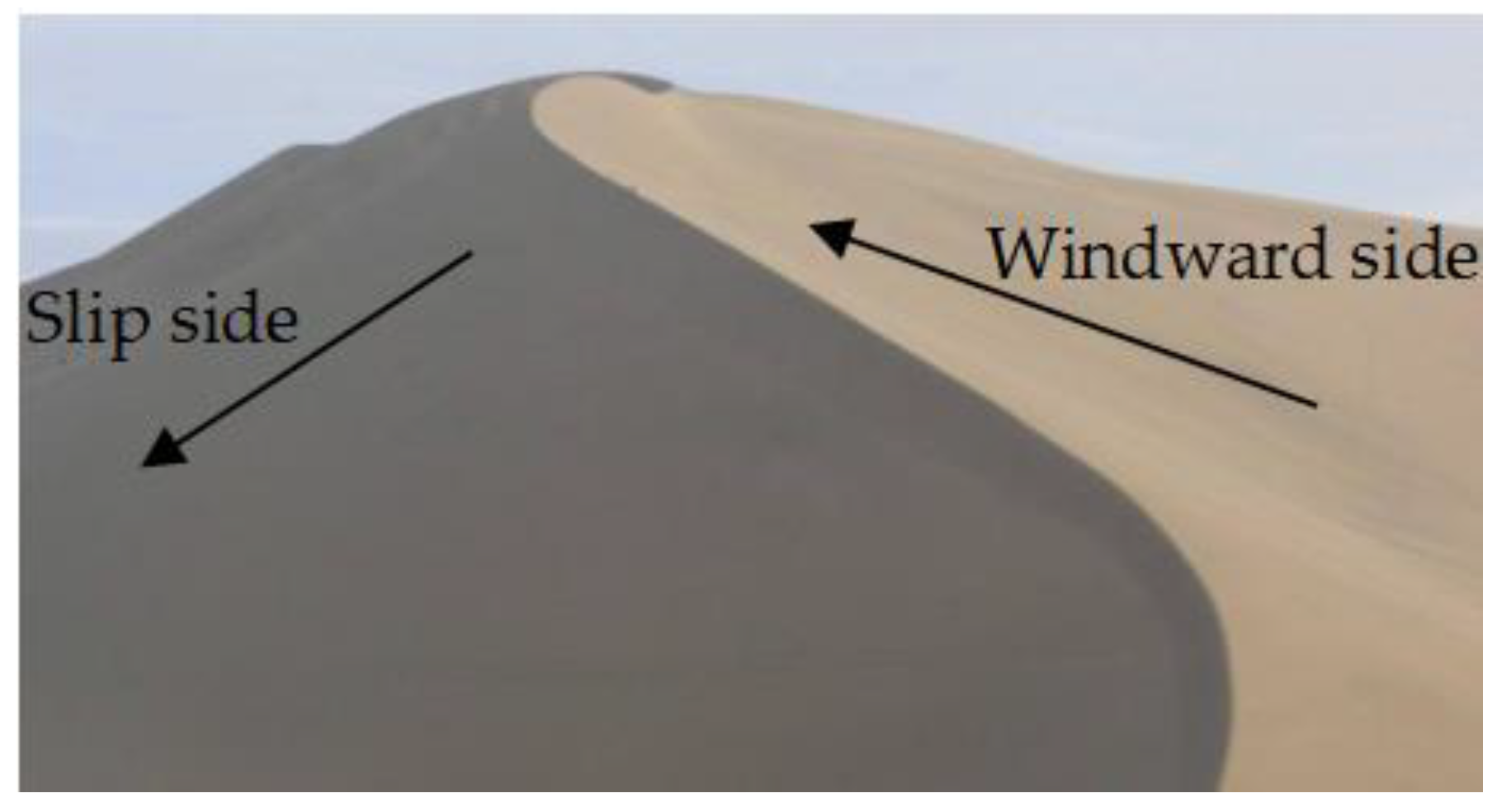
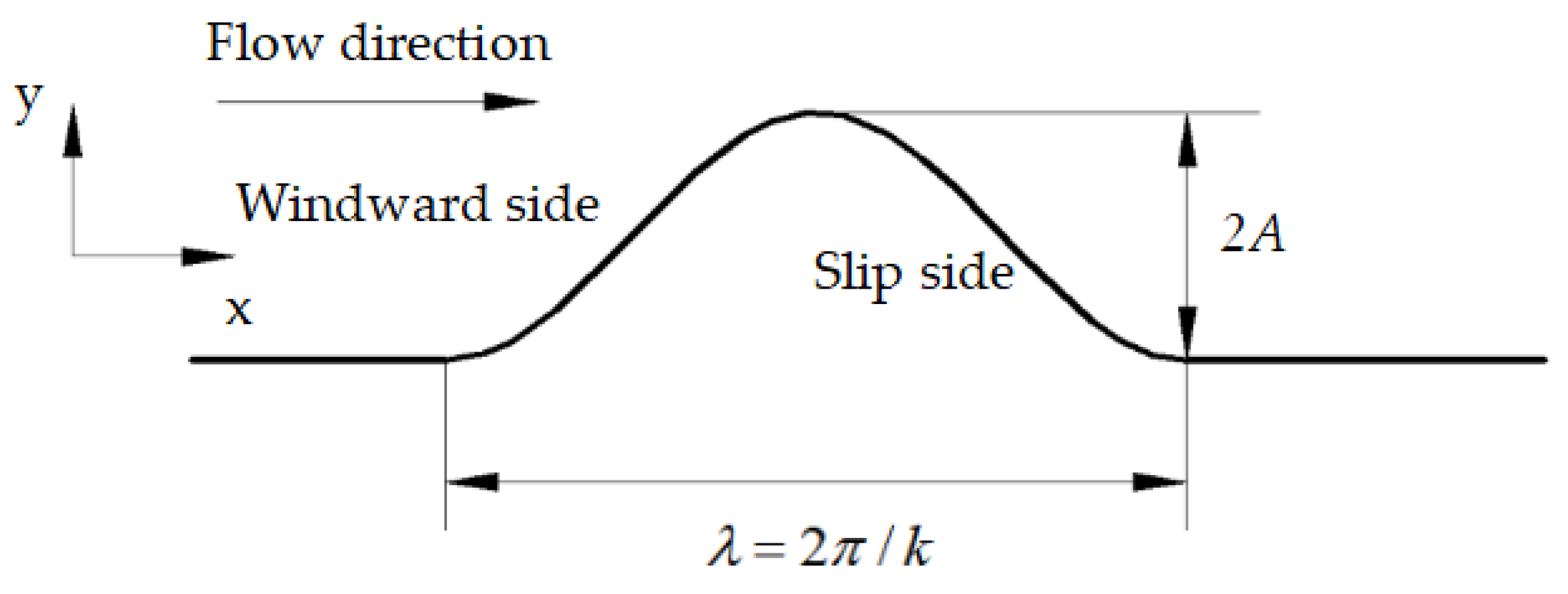


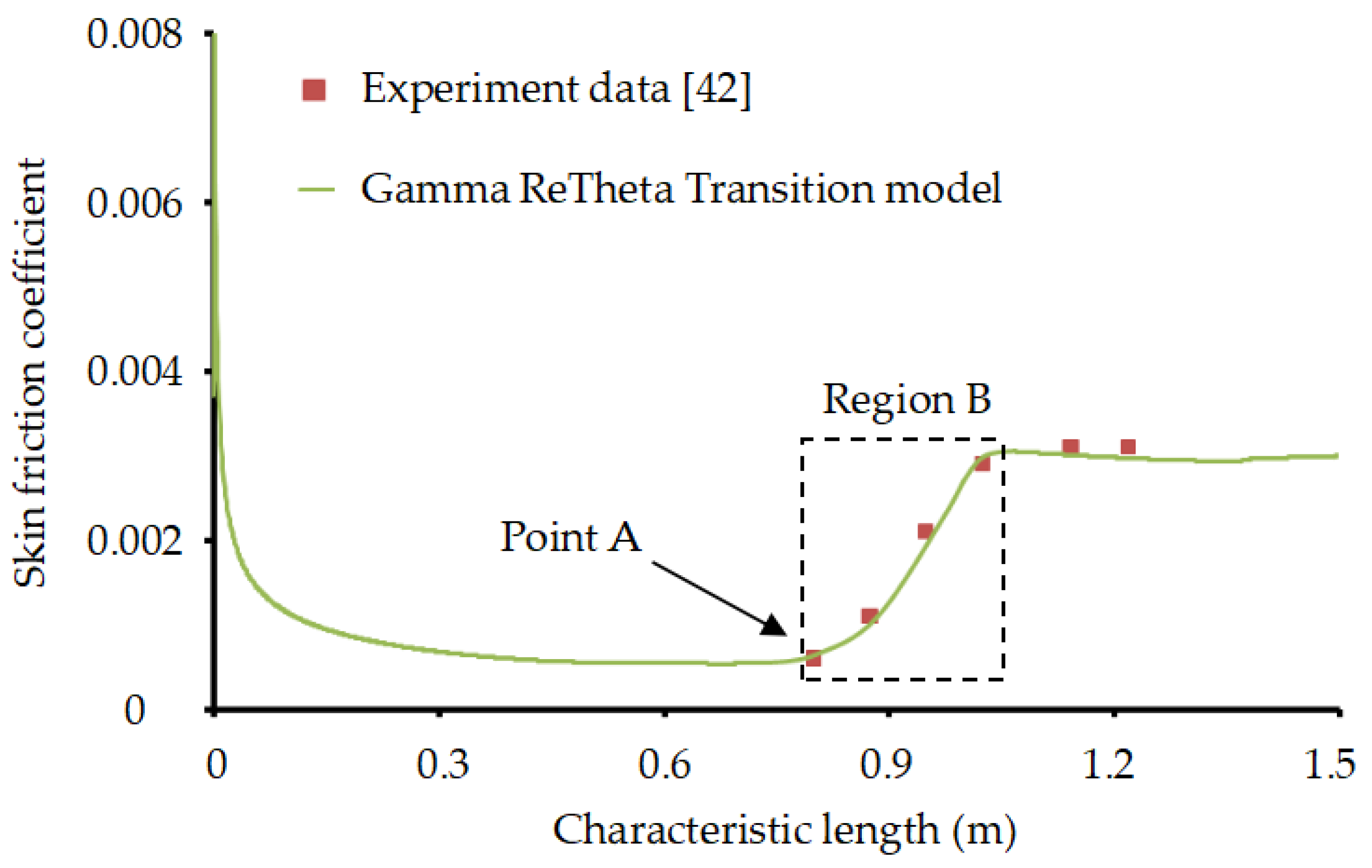
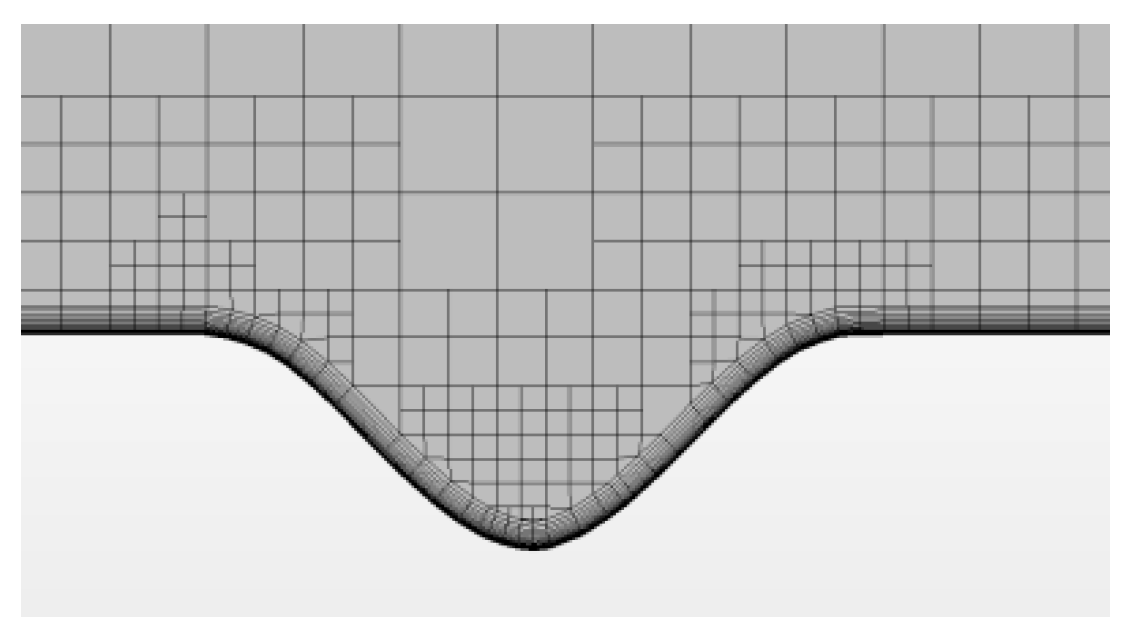

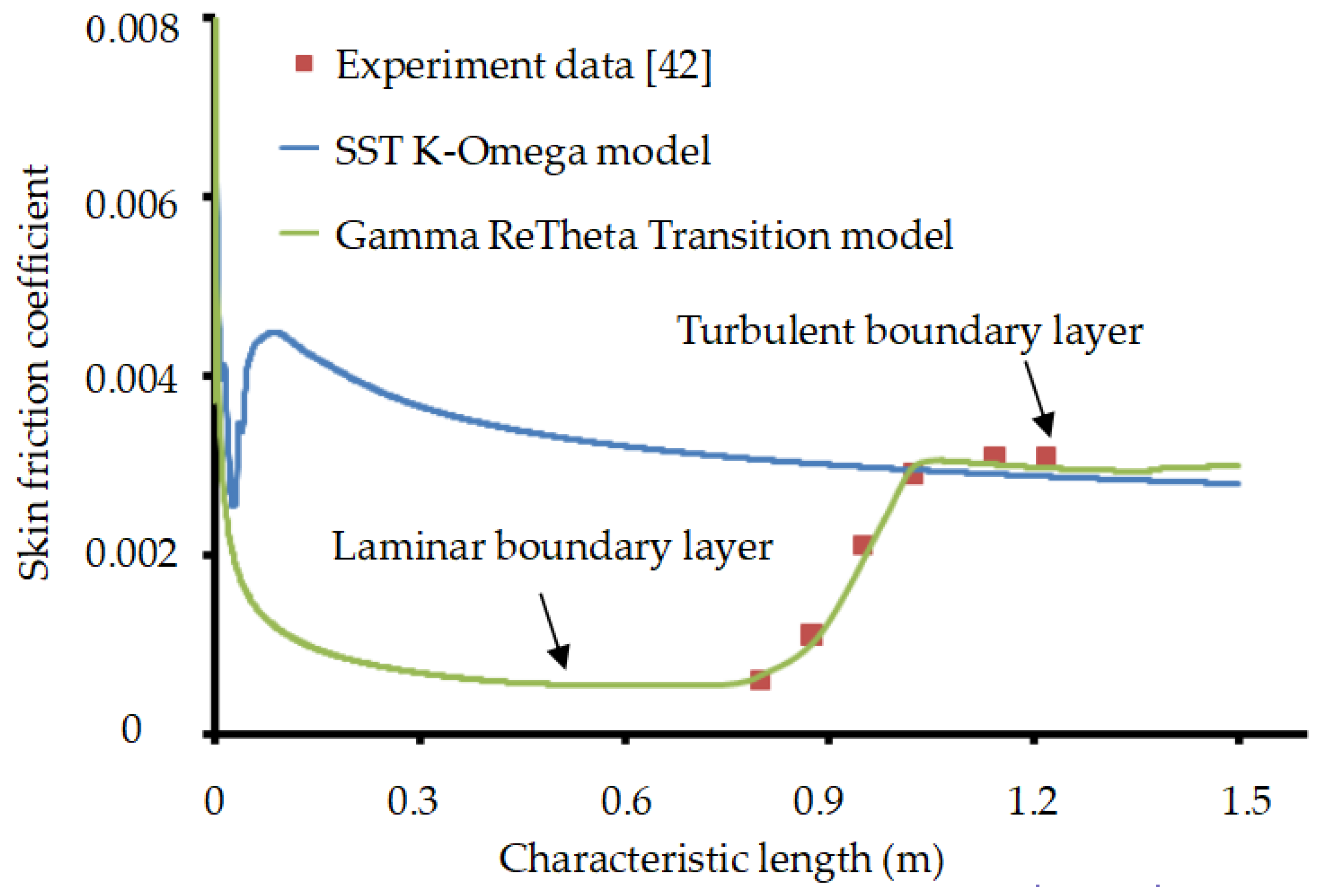
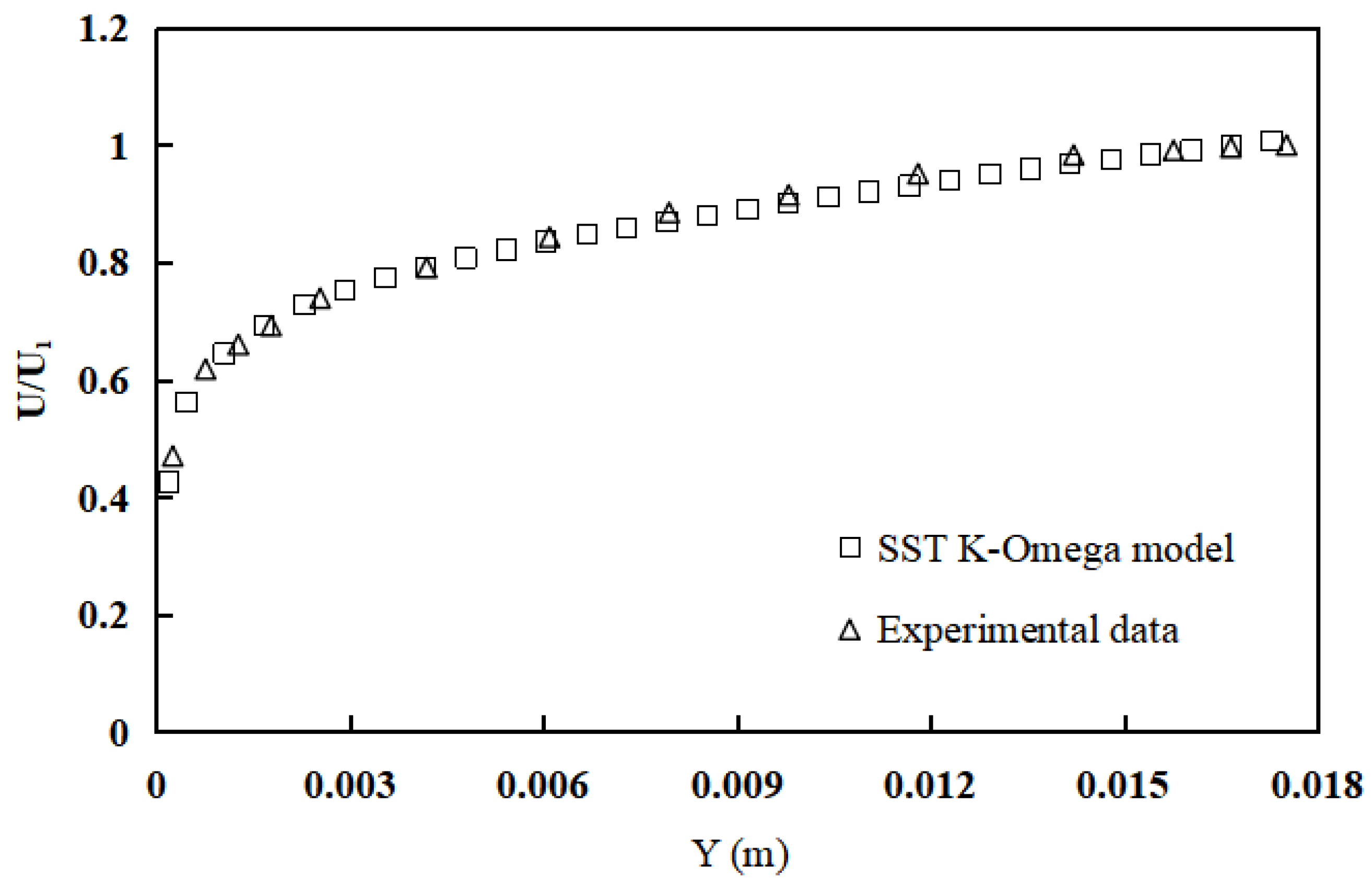
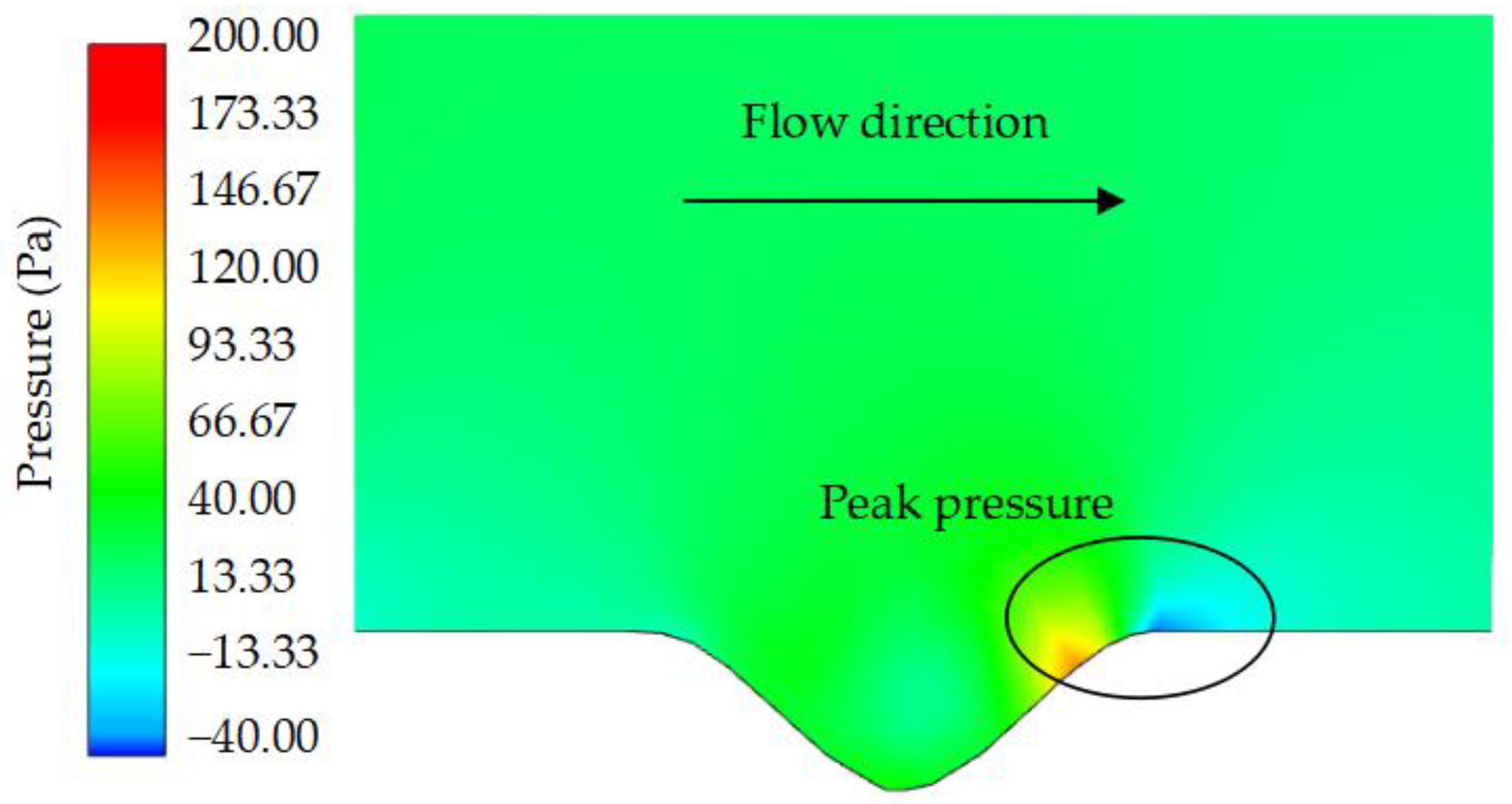


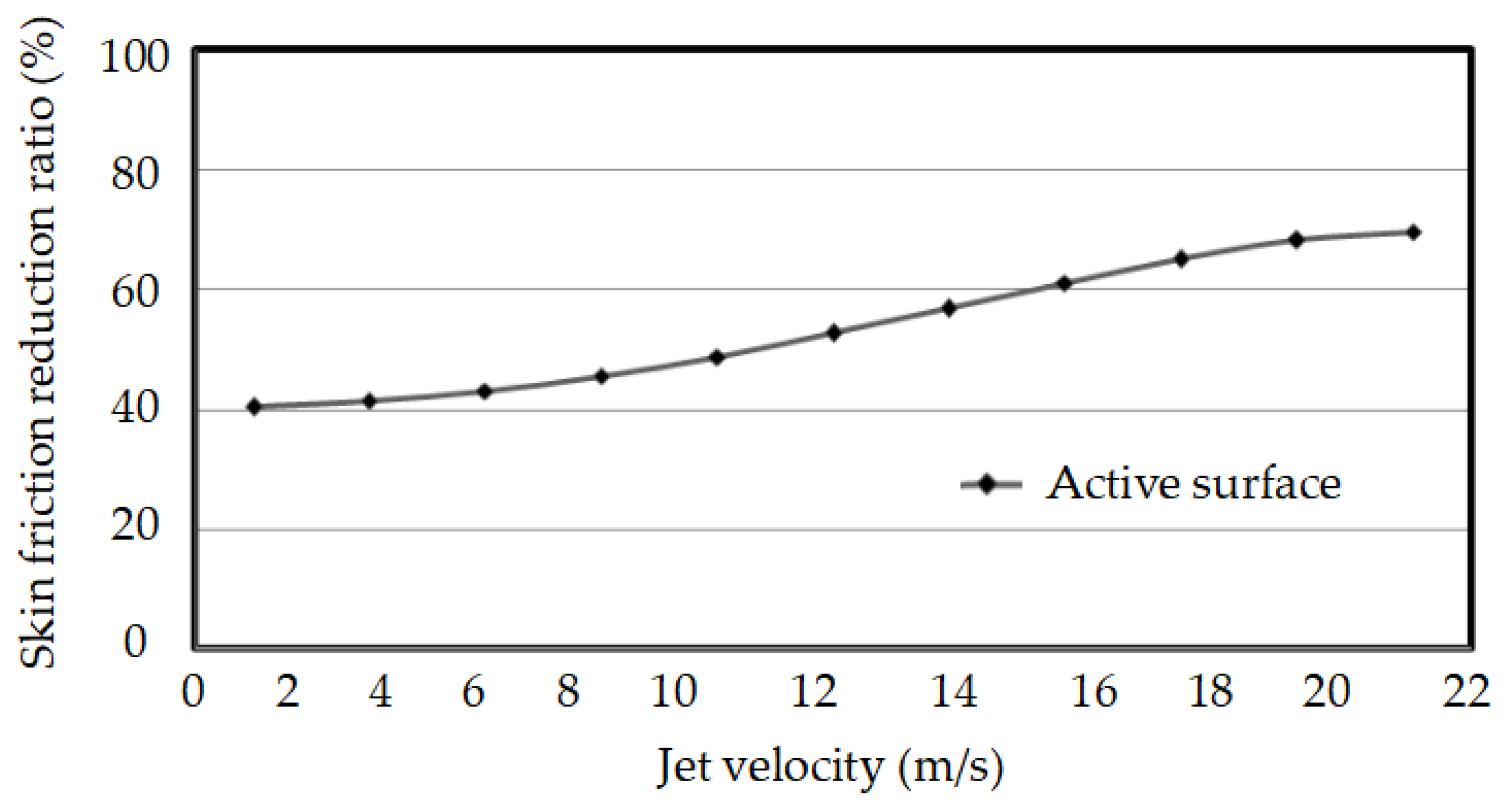
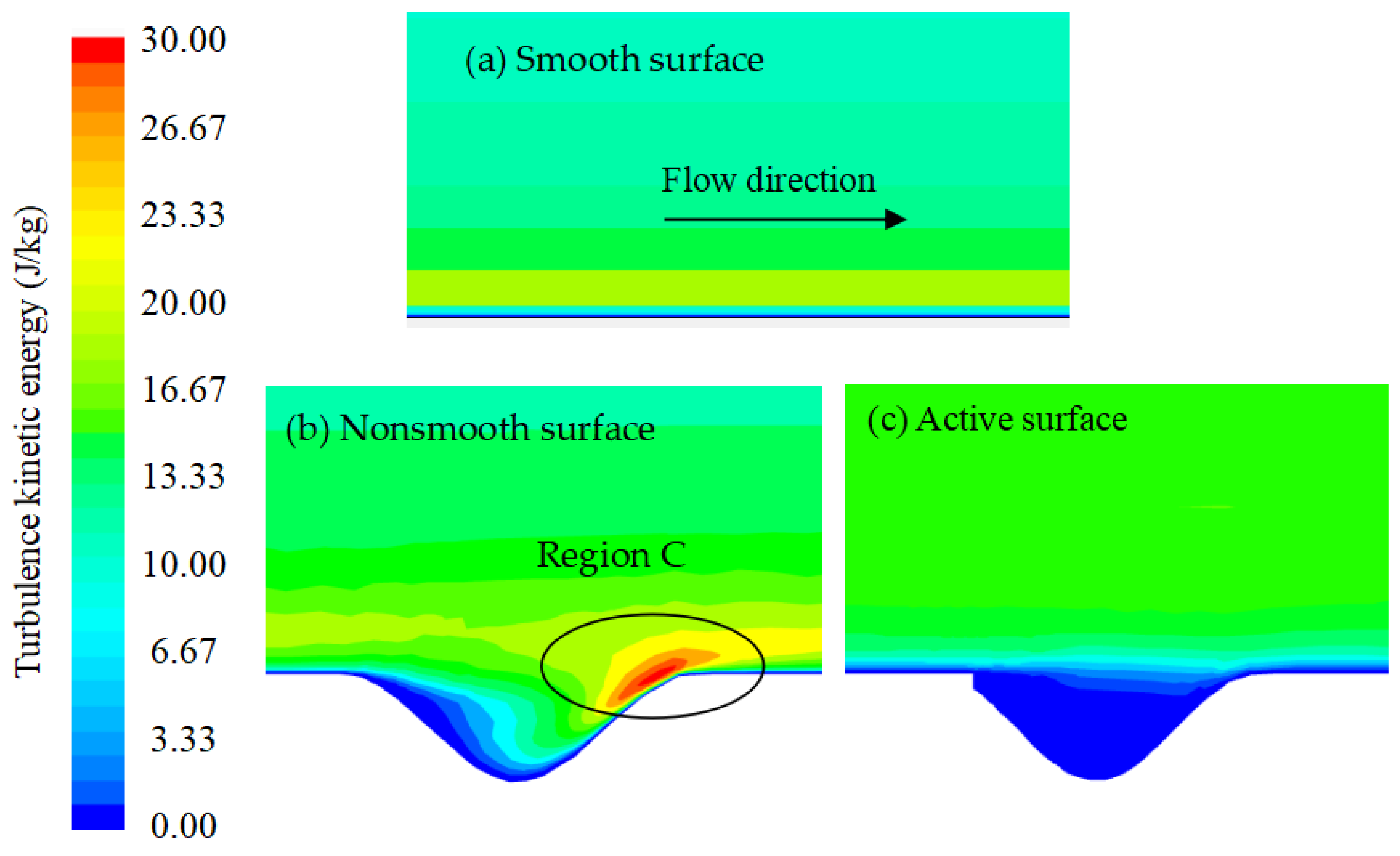
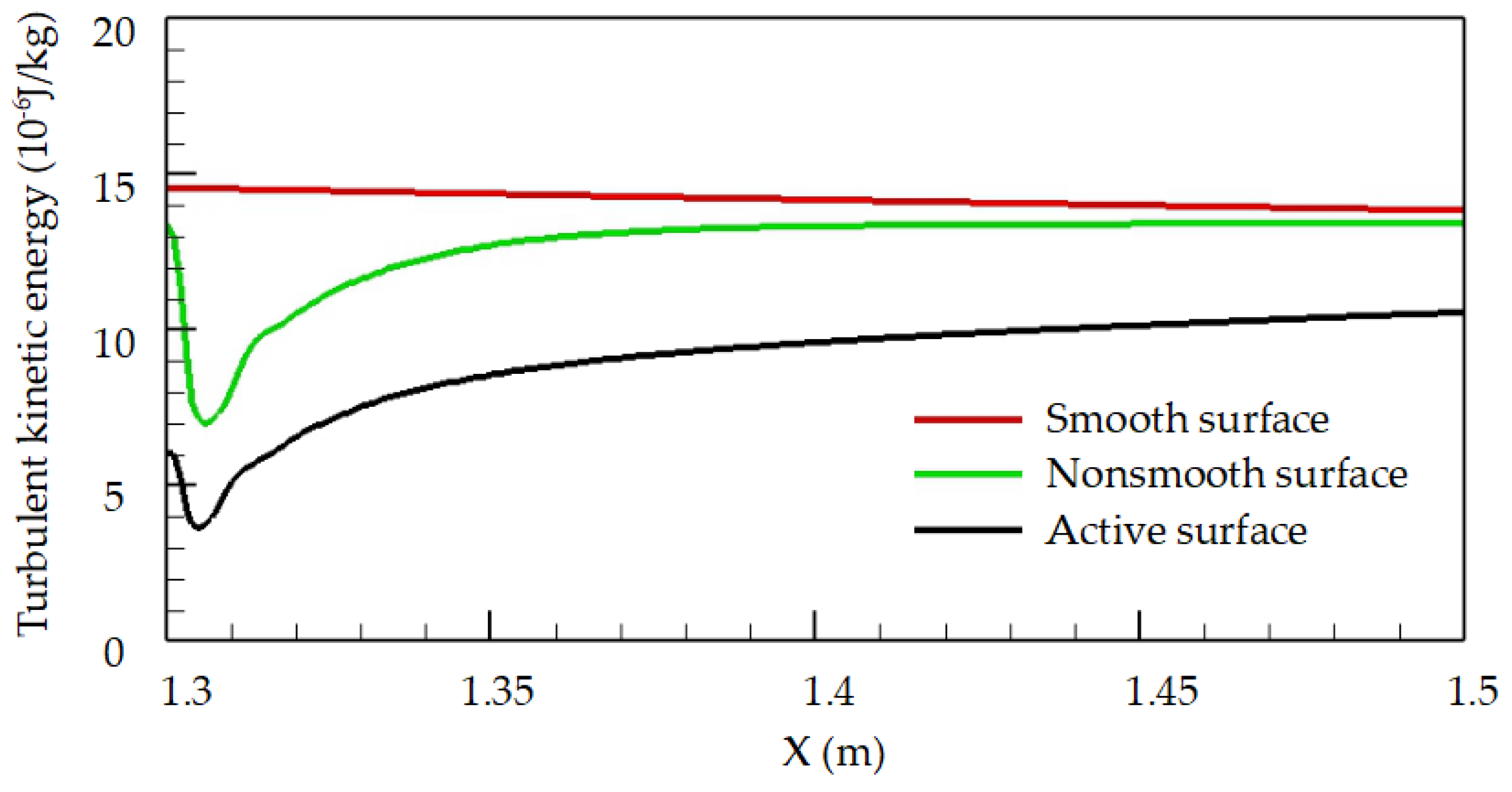
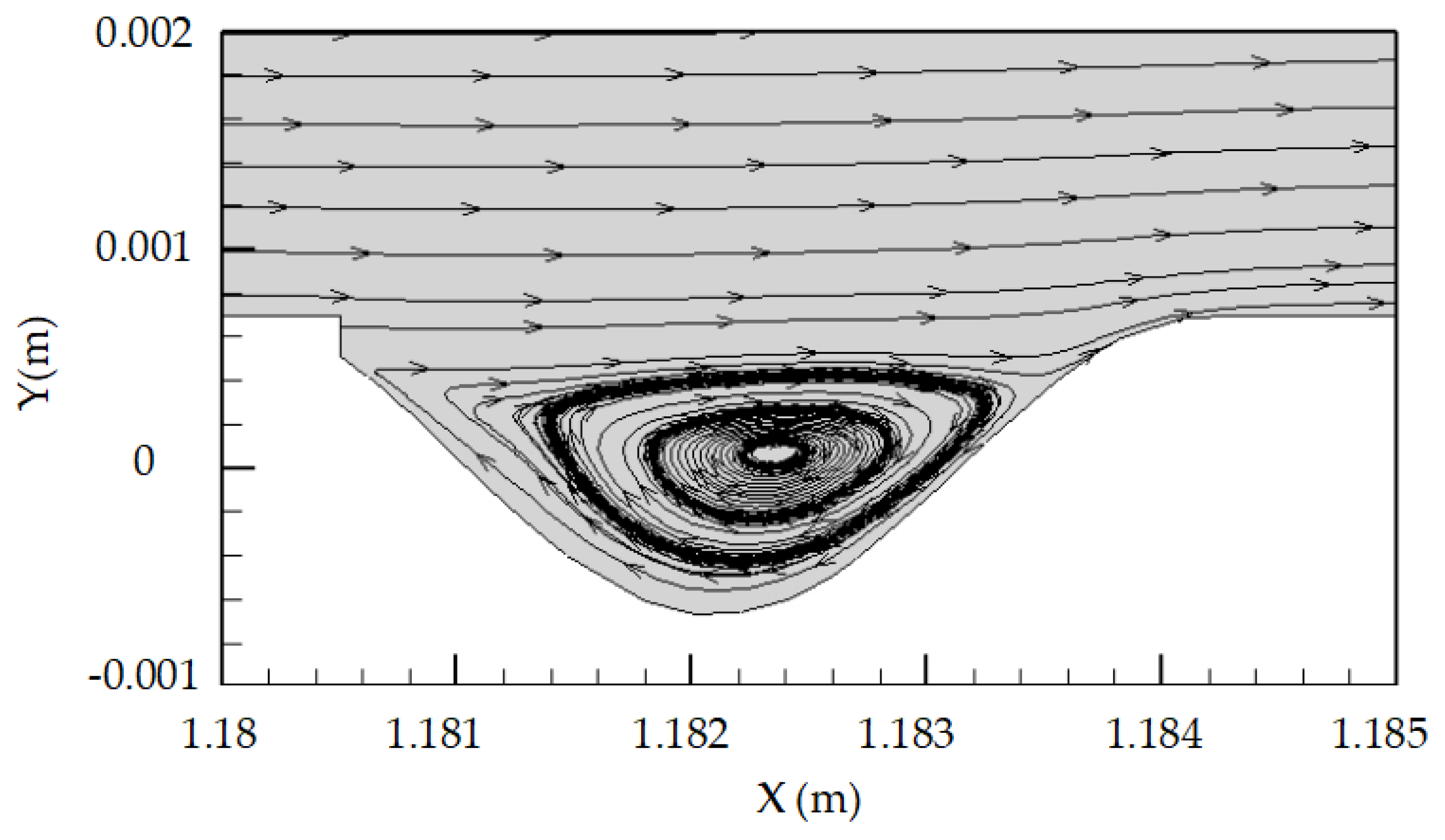

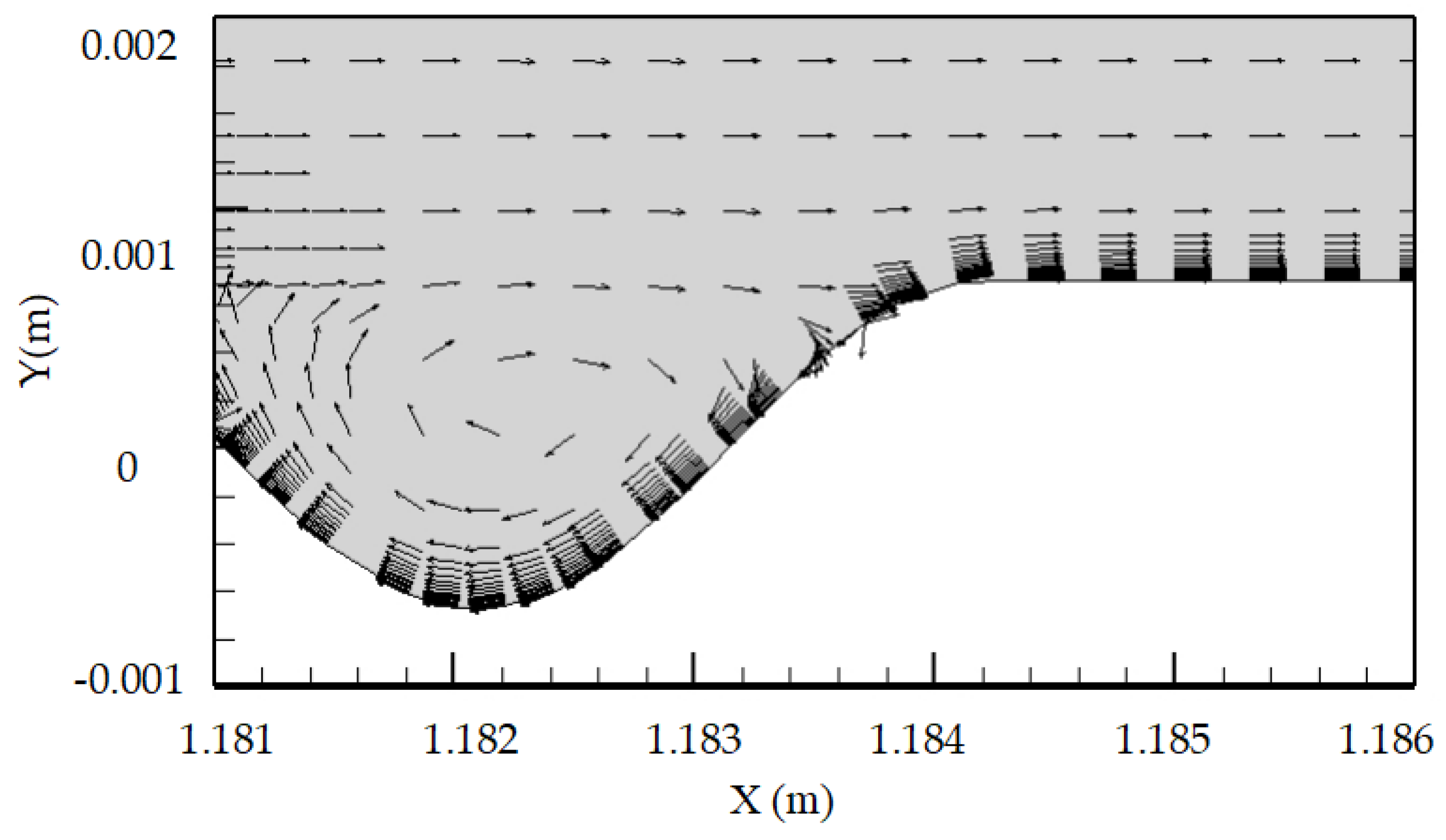
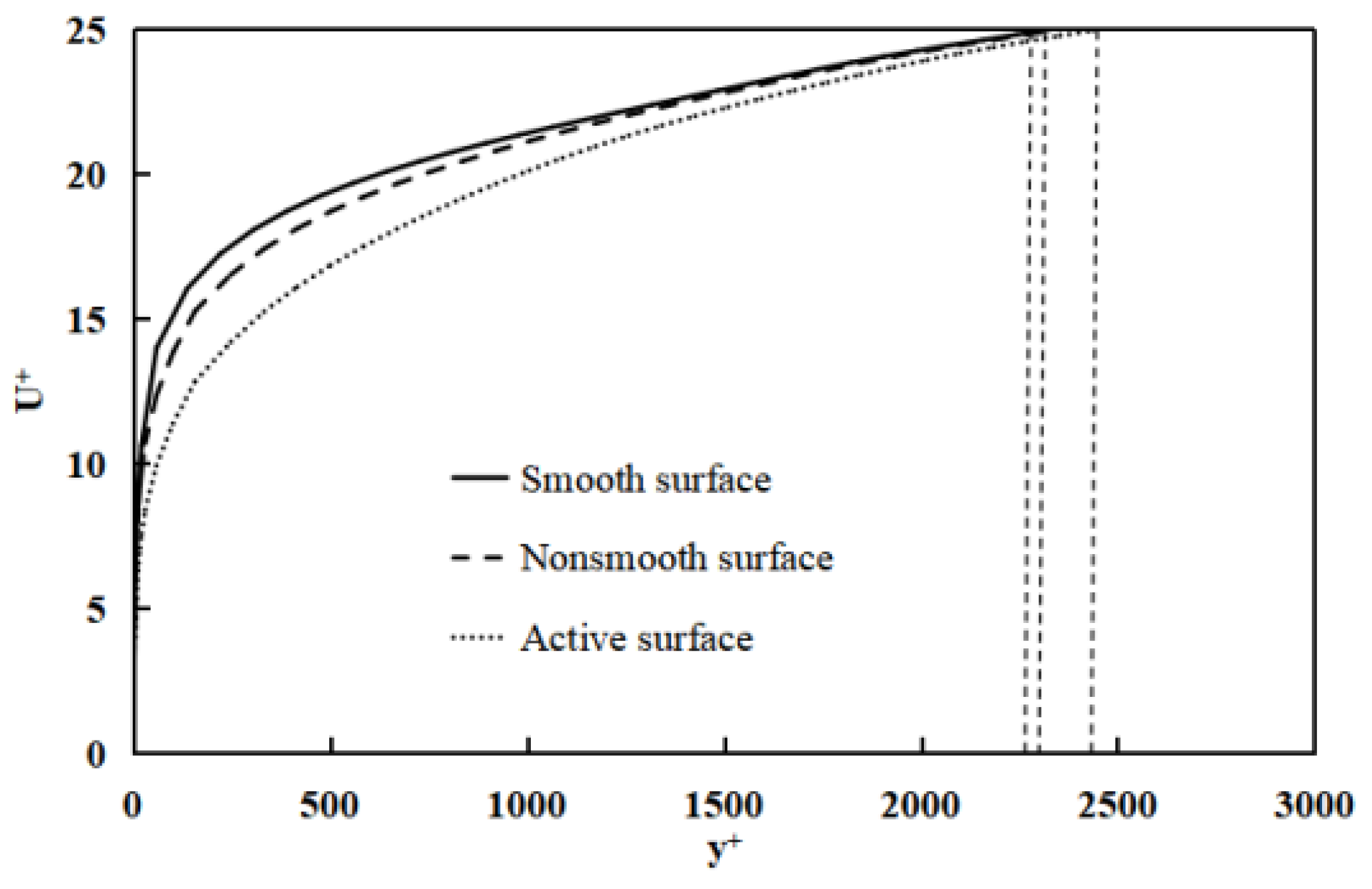
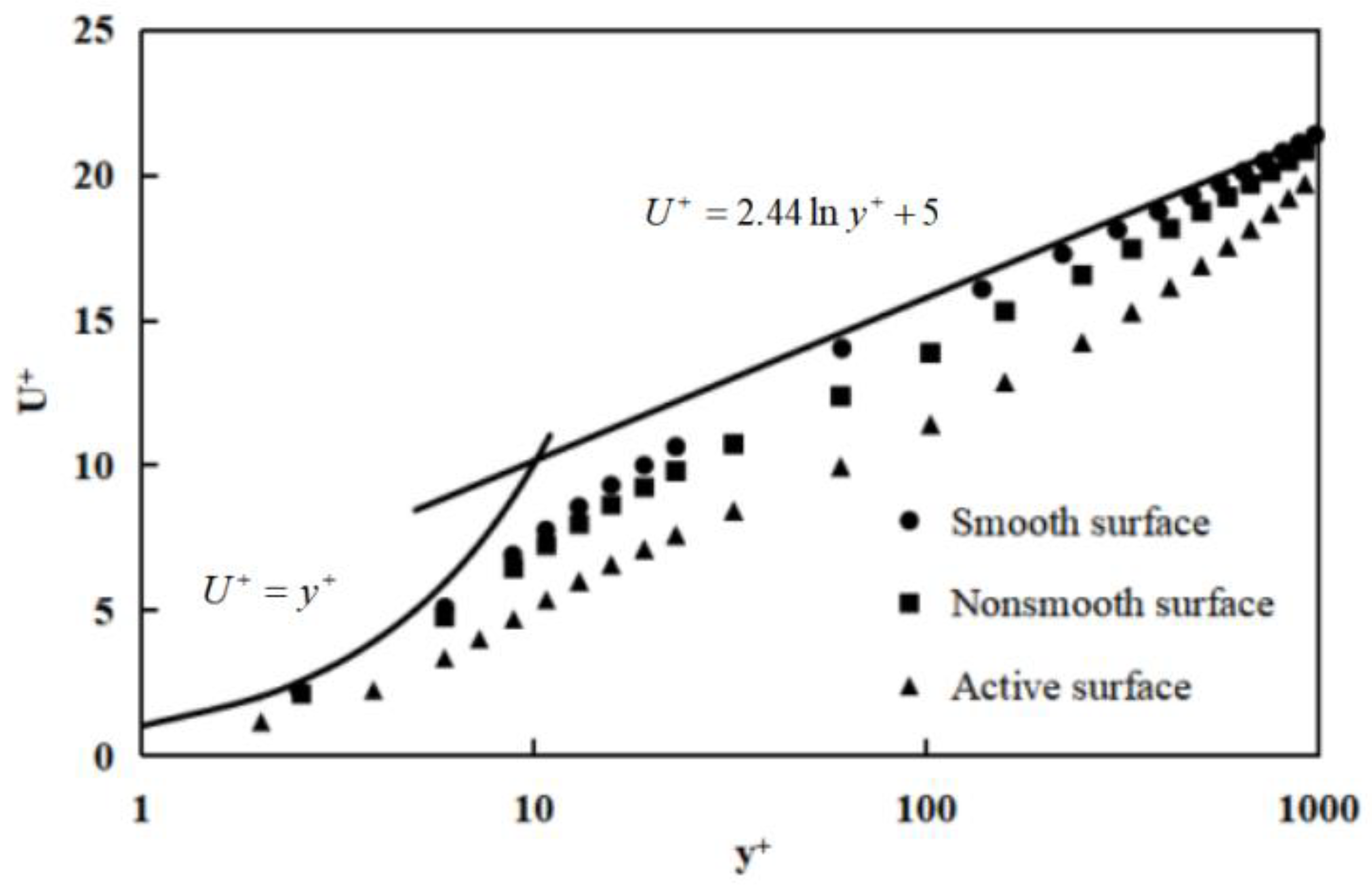

| Grid Quantity | Skin Friction Coefficient |
|---|---|
| 102,505 | 0.00275 |
| 196,784 | 0.00301 |
| 221,027 | 0.00311 |
| 251,215 | 0.00325 |
| 308,794 | 0.00323 |
| Surface Type | Total Drag (N) | RD (%) | Pressure Drag (N) | Skin Friction (N) | Rf (%) |
|---|---|---|---|---|---|
| Smooth surface | 1.312 | - | 0.000 | 1.312 | - |
| Nonsmooth surface | 1.897 | −45.50% | 1.108 | 0.789 | 39.86% |
| Surface Type | Jet Velocity (m/s) | Pressure Drag (N) | Skin Friction (N) | Total Drag (N) | Drag Reduction Ratio (%) |
|---|---|---|---|---|---|
| Smooth surface | - | 0.000 | 1.312 | 1.312 | - |
| Nonsmooth surface | - | 1.108 | 0.789 | 1.897 | −44.50% |
| Nonsmooth surface with jet (active surface) | 1 | 0.971 | 0.783 | 1.755 | −25.19% |
| 3 | 0.742 | 0.770 | 1.511 | −15.16% | |
| 5 | 0.578 | 0.747 | 1.325 | −0.96% | |
| 7 | 0.466 | 0.715 | 1.181 | 11.09% | |
| 9 | 0.422 | 0.672 | 1.094 | 16.63% | |
| 11 | 0.438 | 0.621 | 1.059 | 19.35% | |
| 13 | 0.501 | 0.567 | 1.067 | 18.69% | |
| 15 | 0.605 | 0.511 | 1.116 | 14.96% | |
| 17 | 0.743 | 0.458 | 1.201 | 8.49% | |
| 19 | 0.913 | 0.417 | 1.329 | −1.30% | |
| 21 | 1.088 | 0.399 | 1.488 | −13.36% |
| Surface Type | Skin Friction (N) | Skin Friction Reduction Ratio (%) |
|---|---|---|
| Smooth surface | 0.851 | - |
| Nonsmooth surface | 0.805 | 5.41% |
| Active surface | 0.696 | 18.21% |
© 2019 by the authors. Licensee MDPI, Basel, Switzerland. This article is an open access article distributed under the terms and conditions of the Creative Commons Attribution (CC BY) license (http://creativecommons.org/licenses/by/4.0/).
Share and Cite
Song, X.; Zhang, M. Turbulent Drag Reduction Characteristics of Bionic Nonsmooth Surfaces with Jets. Appl. Sci. 2019, 9, 5070. https://doi.org/10.3390/app9235070
Song X, Zhang M. Turbulent Drag Reduction Characteristics of Bionic Nonsmooth Surfaces with Jets. Applied Sciences. 2019; 9(23):5070. https://doi.org/10.3390/app9235070
Chicago/Turabian StyleSong, XiaoWen, and MingXiao Zhang. 2019. "Turbulent Drag Reduction Characteristics of Bionic Nonsmooth Surfaces with Jets" Applied Sciences 9, no. 23: 5070. https://doi.org/10.3390/app9235070
APA StyleSong, X., & Zhang, M. (2019). Turbulent Drag Reduction Characteristics of Bionic Nonsmooth Surfaces with Jets. Applied Sciences, 9(23), 5070. https://doi.org/10.3390/app9235070





